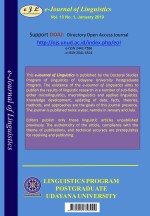The Meaning Difference of Lexicon “Sakit” in Bimanese: A Semantic Perspective
Abstract
The current study attempts to describe the lexicon “sakit” in Bimanese used by Mbojo ethnic group in daily communication and analyze the meaning difference from the semantic perspective. The research applied descriptive qualitative method of analysis and the data were collected by using fishbowl, recording, and note taking technique. Based on the data analysis the findings reveal that thirteen lexicons “sakit“ are used by Mbojo ethnic group in daily communication including supu [supu], hengge [hengge], sari’i [sari’i], rambo [rambo], mbalo [mbalo], mancoro [mancoro], kantero [kantero], duha [duha], pili [pili], ngelu [ngelu], ncara oi [ncara ?wi], mbowi [mb ?wi] and winte [winte].
Downloads
References
Akello, L. D., & Timmerman, M. C. (2017). Local language a medium of instruction: challenges and way Forward. Educational Action Research, 1-19. doi:10.1080/09650792.2017.1319287
Babaci-Wilhite, Z. (2013). Local Languages of Instruction as a Right in Education for Sustainable Development in Africa. Sustainability, 5, 1995-2017. doi::10.3390/su5051994
Bast, H., & Buchhold, B. (2016). Semantic Search on Text and Knowledge Bases. Foundations and Trends in Information Retrieval, 10(2-3), 119-271. doi:10.1561/1500000032
Cruze, D.A. 1986. Lexical Semantics. Cambridge: Cambridge University Press
Fang, T. (2017). How to Maintain a Minority Language through Education. Chinese Studies, 6, 1-11. doi:10.4236/chnstd.2017.61001
Faridy, F., & Syaodih, E. (2017). Analysis on the Importance of Mother Tongue in Early Childhood. 3rd International Conference on Early Childhood Education (ICECE-16). 58, pp. 193-196. Bandung: Atlantis Press.
Hatch, E., & Brown, C. (2001). Vocabulary, semantics and language education. Beijing, China: Foreign Language Teaching and Research Press.
Hussain, S., & Sajid, S. (2015). Semantics in EFL Classroom: A Brief Review. IOSR Journal Of Humanities And Social Science (IOSR-JHSS), 20(9), 39-43. doi:10.9790/0837-20933943
Mahsun. 2012. Metode Penelitian Bahasa. Depok: Kharisma Putra Utama Offset
Novita, S., & Widayati, D. (2018). Kekerabatan Kosa Kata Bahasa Karo, Bahasa Nias, dan Bahasa Simalungun di Kota Medan: Kajian Linguistik Historis Komparatif. Linguistika, 26(2), 109-125
Setiawan, L. G., Beratha, L. S., & Ni Wayan Sukarini. (2019). Meaning of Phrasal Verb ‘pick up’ Subtype do/happen: A Natural Semantic Metalanguage Approach. e-Journal of Linguistics, 13(2), 357-366. doi:10.24843/e-jl.2019.v13.i02.p13
Scarino, A., & Liddicoat, A. J. (2009). Teaching and Learning Languages: A Guide. Australia: GEON Impact Printing Pty Ltd.
Taembo, M., Dhanawaty, N. M., Mbete, A. M., & Putra, A. A. (2018). A Geography Dialect Of Wakatobi Language In Southeast Sulawesi. e-Journal of Linguistics, 12(2), 88-98. doi:10.24843/eJL.2018.v12.i02.p.02
Winer, L. (2005). Indic Lexicon in the English/Creole of Trinidad. New West Indian Guide, 79(1 & 2), 7-30.

This work is licensed under a Creative Commons Attribution 4.0 International License











